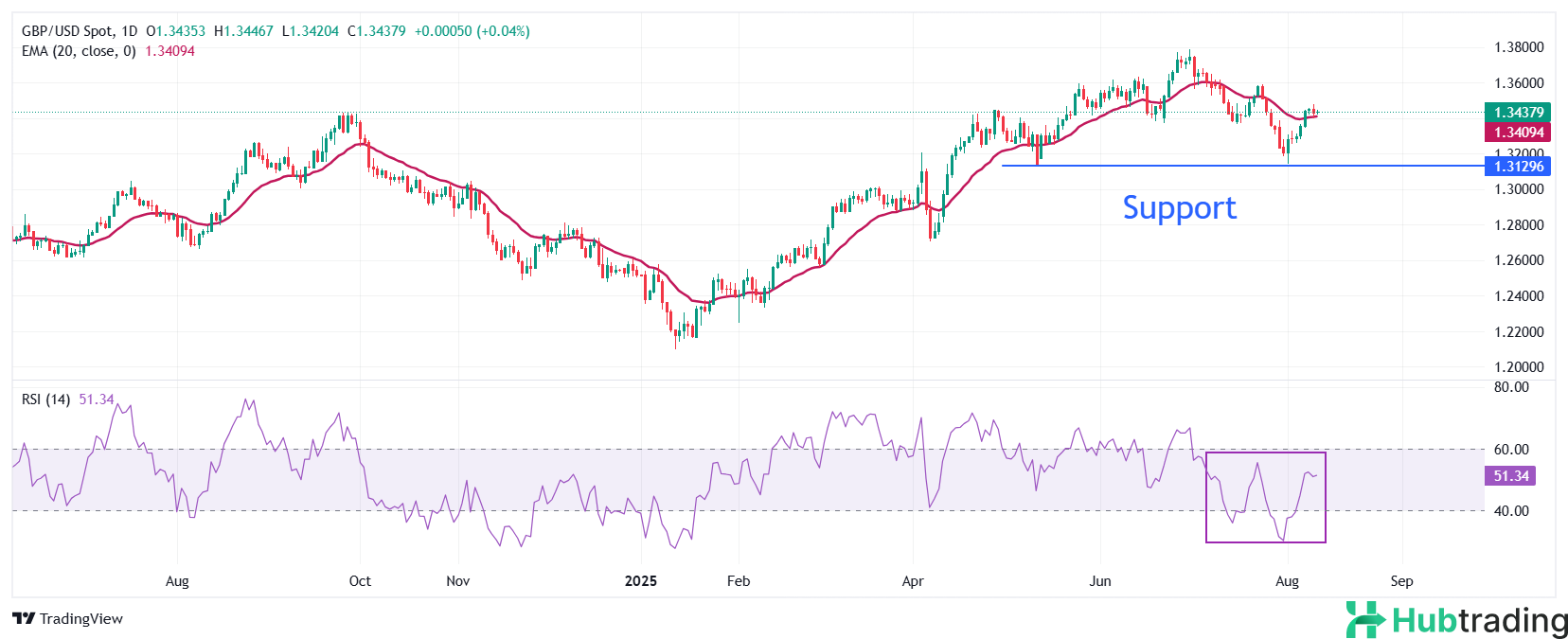-
The Pound Sterling strengthens against major currencies following robust UK employment data for the three months to June.
-
UK Average Earnings growth shows signs of cooling.
-
Market focus shifts to upcoming US inflation figures and the UK Q2 GDP report for further direction.
The Pound Sterling (GBP) gained ground against major peers on Tuesday following the release of upbeat UK labor market data for the three months ending in June.
According to the Office for National Statistics (ONS), the UK economy added 239,000 jobs in the second quarter—sharply higher than the 134,000 added in the three months to May. This marks a notable rebound from earlier signs of hiring hesitation, which were linked to firms facing higher employer contributions to social security, now at 15%.
The ILO Unemployment Rate held steady at 4.7%, in line with expectations. Meanwhile, the Claimant Count Change for July surprised to the downside, falling by 6,200 versus an anticipated increase of 20,800.
Wage growth showed mild signs of cooling. Average Earnings excluding bonuses rose 5% year-over-year, meeting forecasts, while Average Earnings including bonuses grew at 4.6%, slightly below the expected 4.7% and down from the previous 5%.
The solid job growth may support the Bank of England’s (BoE) current “gradual and careful” approach to monetary easing. Last week, the BoE trimmed interest rates by 25 basis points to 4%, with the decision narrowly passed.
Looking ahead, investor attention turns to the UK’s Preliminary Q2 GDP and June factory output data, both due for release on Thursday.
Daily Digest Market Movers: Pound Sterling Steadies Ahead of Key US Inflation Data
- The Pound Sterling (GBP) recovered early losses and is trading flat around 1.3440 against the US Dollar (USD) during Tuesday’s European session, as markets await the release of crucial US Consumer Price Index (CPI) data for July at 12:30 GMT. The inflation print is expected to significantly influence the USD’s direction, especially as investors assess whether recent price increases are temporary or part of a sustained trend.
- At the time of writing, the US Dollar Index (DXY)—which measures the Greenback’s strength against a basket of six major currencies—trades steadily near a two-day high around 98.50.
- Consensus forecasts see headline US inflation rising to 2.8% in July, up from 2.7% in June. Core CPI, which strips out volatile food and energy components, is projected to increase to 3.0% YoY from 2.9%. On a monthly basis, headline and core inflation are expected to rise by 0.2% and 0.3%, respectively.
- Stronger-than-expected inflation data could challenge market expectations of rate cuts by the Federal Reserve at its September meeting. Conversely, softer inflation figures may reinforce the case for monetary easing.
- Recent commentary from Federal Reserve officials reflects a shift in focus from inflation toward weakening labor market conditions. Over the weekend, Fed Governor Michelle Bowman emphasized the need to gradually shift from a restrictive policy stance to a more neutral setting, citing July’s employment data as supportive of her view for three rate cuts this year.
- On the trade front, the United States and China have extended their tariff truce for another 90 days. China’s Commerce Ministry announced efforts to ease non-tariff barriers for American firms and temporarily suspend the addition of certain US companies to its unreliable entity and export control lists.
Technical Analysis: GBP/USD Maintains Bullish Potential Above 20-Day EMA

The GBP/USD pair remains stable around 1.3440, holding above the 20-day Exponential Moving Average (EMA), which is currently around 1.3408—indicating a short-term bullish bias.
The 14-day Relative Strength Index (RSI) has rebounded above the 50.00 mark after fluctuating in the 20.00–40.00 range in recent sessions, signaling the potential for a bullish reversal.
To the downside, key support lies at the August 1 low of 1.3140. On the upside, resistance is expected near the July 23 high of 1.3585.





